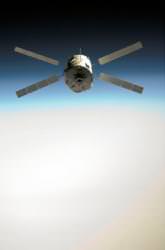Europe's Automated Transfer Vehicle "Jules Verne" pulled into port today, docking successfully with the International Space Station, bringing 7.5 tons of cargo to re-supply the station. The ATV's maiden docking took place in slow, incremental steps, and included several docking run-throughs and planned aborts to test vehicle's capability of being monitored and stopped in case of any problems. But under the watchful eye of three control centers on Earth and the three astronauts on board the ISS, the Jules Verne approached and docked smoothly to the docking ring on the Zvezda module at 9:45 am CDT.
Jules Verne is about the same size as the Apollo crew capsule at 10.3 meters long and 4.5 meters in diameter. The 20 ton vehicle can ferry about three times the amount of cargo as the Russian Progress re-supply vehicle. This big cargo capacity will prove especially important when the shuttles quit flying in 2010. The crew on board the ISS will open the hatches later today and begin unloading supplies, including fresh food, water, rocket propellant and new equipment. Also, handwritten manuscripts by 19th century science fiction writer Jules Verne, after whom the ATV is named, are on board the spacecraft.
The ATV used GPS and an onboard laser guidance system to hook up precisely with the station. With triple redundancy, the software employed by the ATV has been heavily tested by the ESA. Flight controllers in the ATV Center in Kourou, France, the Russian control center in Kouriloff, and Mission Control in Houston worked together to choreograph the flawless docking.
Today’s docking ends a 26 day journey for the ATV. It launched on March 9 on board a Arianne 5 rocket from Kourou, French Guiana, and remained in a holding orbit while the recent shuttle mission, STS-123, had shuttle Endeavour docked to the station. The ATV then began a series of demonstration tests to make sure all systems were working correctly. Jules Verne was the largest cargo ever carried into orbit by the Arianne 5 rocket.
The AVT's exterior is covered with an insulating foil layer on top of anti-meteorite Whipple Shields. The X-shaped extended solar arrays look like a metallic blue wings.
Every 12 months or so future ATVs will bring more cargo to the ISS, in orbit about 400 km (230 miles) above the Earth. The Jules Verne will remain docked to the station as a pressurized "waste basket" for up to six months until its final mission: a fiery one-way trip into the Earth's atmosphere to dispose of up to 6.5 tons of station waste.
Ian O'Neill also contributed to this article.
Original News Source: NASA TV
 Universe Today
Universe Today
